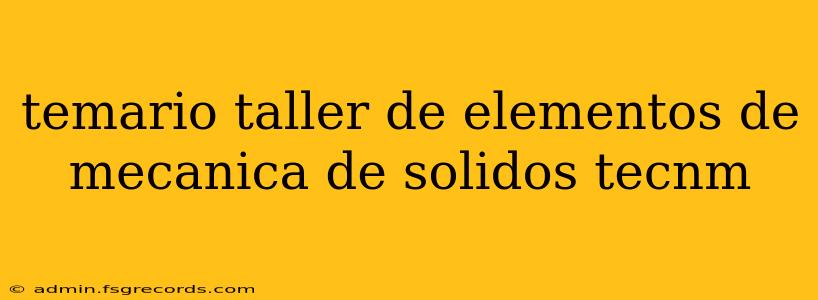Temario Taller de Elementos de Mecánica de Sólidos (TecNM)
This document outlines a comprehensive syllabus for a workshop on Elements of Solid Mechanics, tailored for students in the TecNM system. The focus is on practical application and problem-solving, complementing theoretical coursework. The specific content can be adjusted based on the students' prior knowledge and the workshop's duration.
Module 1: Introduction to Stress and Strain
- 1.1 Concepts of Stress:
- Definition and types of stress (normal, shear).
- Stress tensor and its components.
- Stress transformations (Mohr's circle).
- Principal stresses and maximum shear stress.
- Stress concentration factors. Practical examples and case studies will be included.
- 1.2 Concepts of Strain:
- Definition and types of strain (normal, shear).
- Strain tensor and its components.
- Strain transformations.
- Principal strains and maximum shear strain.
- Relationship between stress and strain (Hooke's Law). Discussions will include limitations and applications of Hooke's Law.
- 1.3 Workshop Activities:
- Hands-on exercises using stress and strain analysis software.
- Problem-solving sessions focusing on real-world engineering scenarios. Emphasis will be placed on interpreting results and drawing conclusions.
Module 2: Axial Loading and Torsion
- 2.1 Axial Loading:
- Stress and deformation in axially loaded members.
- Static equilibrium and free body diagrams.
- Saint-Venant's principle and its implications.
- Design considerations for axially loaded members.
- 2.2 Torsion:
- Shear stress and strain in circular shafts.
- Torsional moment and angle of twist.
- Design of shafts for torsion.
- Torsional stress concentration.
- 2.3 Workshop Activities:
- Experiments on axial loading and torsion using simple testing machines. Data analysis and report writing will be part of the process.
- Design projects involving the selection of appropriate materials and dimensions for axially loaded and torsional members.
Module 3: Bending and Shear
- 3.1 Bending Stress:
- Flexural formula for beams under bending.
- Shear and bending moment diagrams.
- Deflection of beams using various methods (e.g., double integration, superposition).
- Composite beams.
- 3.2 Shear Stress:
- Shear stress distribution in beams.
- Shear center and its importance.
- 3.3 Workshop Activities:
- Experiments involving bending and shear tests on beams. Students will learn how to analyze the experimental data to validate theoretical models.
- Design project focused on optimizing beam dimensions for specific loading conditions. This will include considerations for deflection and stress limitations.
Module 4: Combined Loading and Failure Theories
- 4.1 Combined Loading:
- Analysis of members subjected to combined axial, bending, and torsional loads.
- Stress element analysis for combined loading.
- 4.2 Failure Theories:
- Maximum shear stress theory.
- Distortion energy theory (von Mises).
- Application of failure theories in design.
- 4.3 Workshop Activities:
- Numerical simulations of members under combined loading scenarios.
- Case studies involving failure analysis of engineering components. This section encourages critical thinking and problem-solving in a practical context.
Assessment:
The final grade will be based on participation in workshop activities, problem-solving sessions, and the design projects. Emphasis will be placed on practical application and understanding of the concepts.
This temario provides a solid foundation for a practical workshop on Elements of Solid Mechanics. The inclusion of hands-on activities and design projects will enhance students' understanding and prepare them for real-world engineering challenges. Remember to adapt the content and depth based on the specific needs and level of the students.

